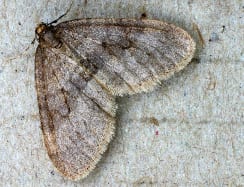Winter Moth decimated shrubs and trees in my yard this spring, from blueberry bushes to maple trees. Are there eco-friendly options for control in the fall? Do I have to spray?
For very up-to-date control methods for winter moth, check www.UMassGreenInfo.org. Then discuss control options with a certified arborist. The UMass fact sheets on this and other insect pests are excellent and give you a realistic approach to toxic vs. non-toxic controls.
Bruce Wenning, Horticulturist, The Country Club, Brookline, MA
Winter moth (Operophtera brumata) has become a significant pest problem in our area (New England). There have been occurrences in other regions of North America for decades, but it was thought to have first arrived in New England on a storm in the late 90s, with the first occurrences noted in the shoreline area south of Boston. It’s been moving steadily west and north since then.
Unfortunately, given the life cycle of this pest, there’s nothing that can be done in the fall to control it. Adults emerge in the late fall, usually from around Thanksgiving through mid-December. They mate and the females lay eggs which overwinter, mostly on twigs and branches of trees and shrubs. The eggs hatch in the spring, around the time many trees are beginning to leaf out.
The earliest treatments can usually be applied in the late winter or early spring. Spraying is really the only effective measure at our disposal. Dormant oil can work, but it doesn’t always reach all the eggs, some of which may be located in bark crevices and shielded from the spray. Another issue is that the newly hatch caterpillars can “balloon” (swing, Spiderman-like, from adjacent trees on silk webs) onto trees that have been treated. For these reasons, some sort of follow-up spraying will be needed for a few weeks following egg hatch.
Insecticides based on pyrethrins, spinosyns, or Bt are relatively low-risk and effective for control of winter-moth larvae. Spinosyns and pyrethrins, though, are broad-spectrum insecticides, and need to be used with some care, especially if there are any pollinator-attracting, blooming plants in the areas to be sprayed.
For landscape trees, spraying can be done when the first feeding damage on leaves is noted. But with fruit-bearing plants from which a harvest is expected – blueberries, apples, pears, etc. – the winter moth larvae can tunnel into fruit buds even before they fully open and destroy the bud, so control should aim for targeting the larvae at the time of egg hatch.
Growing-degree day accumulation provides a tool for anticipating egg hatch. References most often give 20–50 GDD (base 50) and 177–239 GDD (base 40) for the hatch window. In my experience (in eastern MA), I’ve found these to be a bit premature, with significant egg hatch beginning a week or so after this.
Given the ballooning ability of these critters, and the relative short-term residual period of activity of these materials, one may have to do a number of applications for effective control. Most years, I find I need to do three applications.
Weather.com provides a growing-degree-day calculator. It used to be accessible in the Farmers’ Forecast section, but I don’t see a link for it there now. You can still reach it by entering “growing degree calculator” into the search function.
A parasitic fly, Cyznis albicans, which only preys on winter moth, has been released in selected areas, and is proving to be somewhat successful in controlling this insect on a larger scale, but it will take more releases and more time before the overall population is measurably compromised.
More information about winter moth can be found on these UMass Extension Web sites:
Winter Moth Overview | UMass Amherst Landscape, Nursery & Urban Forestry Program
Winter Moth Identification & Management | UMass Amherst Landscape, Nursery & Urban Forestry Program
Nick Novick, Small Planet Landscaping, Ashland, MA


